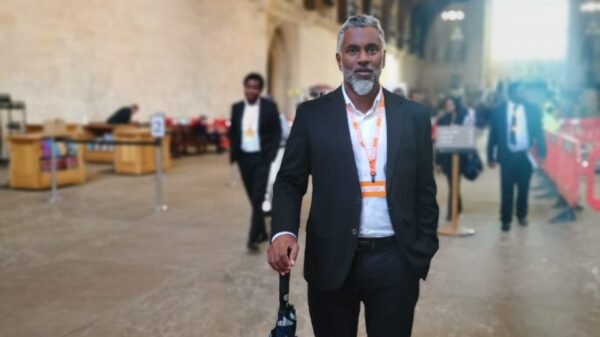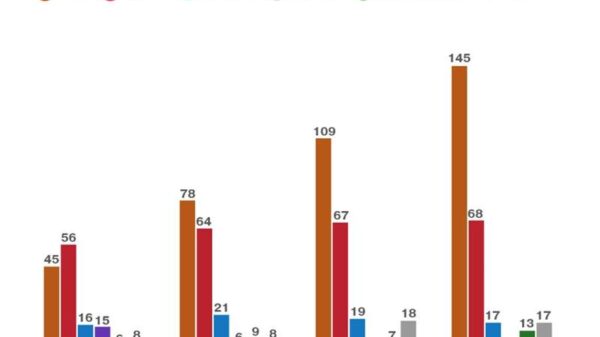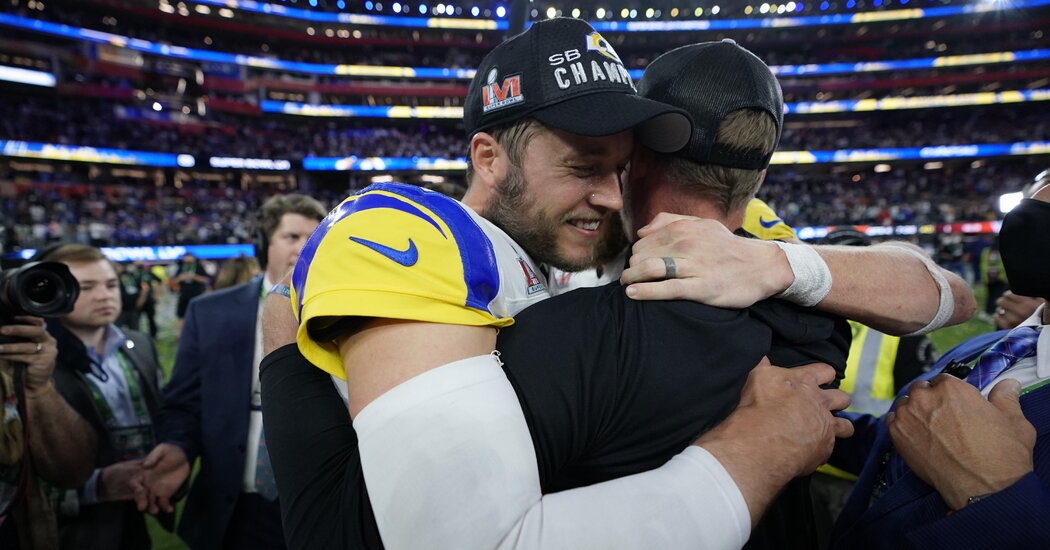Bartering draft capital to acquire Matthew Stafford and other stars, the Rams traded their future for a shot at a championship. Sunday’s win over the Cincinnati Bengals validated the risk.
INGLEWOOD, Calif. — The Los Angeles Rams know there are many ways to win in the modern N.F.L., yet every year 31 of them are wrong. The only methodology conclusively confirmed to work belongs to the team hugging and crying beneath cascading confetti after the season’s final game. On Sunday night, that falling royal blue and yellow confetti validated the Rams’ iconoclastic team-building approach that upended a hidebound league.
Los Angeles hired the youngest coach in N.F.L. history. Instead of hoping first-round draft picks would become stars, the team traded them for proven A-listers. The Rams dealt a quarterback who played in a Super Bowl — because they did not think Jared Goff could lead them to another — for one, the veteran Matthew Stafford, who had never won a playoff game.
In a fitting climax to this exhilarating, disjointed mess of a season, Los Angeles scored a late touchdown to topple the upstart Cincinnati Bengals, 23-20, on its home field at SoFi Stadium, the $5 billion bauble erected by the Rams’ owner, E. Stanley Kroenke. It was the Rams’ second Super Bowl title and first since moving westward six years ago to a land of excess and extravagance that reflects their roster, which abounds with standouts by design.
The electrifying ending — punctuated by Stafford’s third touchdown pass, a 1-yarder to Cooper Kupp with 1 minute 25 seconds remaining — marked a worthy coda to the N.F.L.’s longest season, 23 weeks of the regular season and postseason laced with parity and unpredictability. The staffing uncertainty wrought by the coronavirus, in the second season played amid a pandemic, created a cavalcade of upsets that funneled into the postseason: Five of the last six games before Sunday were decided on the final play.
All that mayhem attracted millions upon millions of viewers — television ratings, the N.F.L.’s highest since 2015, soared 10 percent from last season — allowing the league to steamroller on past various scandals, play its games into the middle of February and go head-to-head with the Beijing Olympics. On Sunday, all who tuned in, an ever-growing global audience, were treated to a captivating game, with only one possession separating the teams for nearly the final 36 minutes.
Appearing in its first Super Bowl in 33 years, Cincinnati lost in a way that evoked its last visit. With the Bengals leading, 20-16, midway through the fourth quarter — the same score they lost by to San Francisco in Super Bowl XXIII in 1989 — a dropped ball again conjured unpleasant memories. Doomed back then by Lewis Billups’s muffed end-zone interception, Cincinnati had to punt Sunday when Tyler Boyd — who had no drops during the regular season — couldn’t hold onto a third-down pass.
“I am human,” said Boyd, adding, “I do not beat myself up over things like that.”
Taking over at their 21-yard line with 6:13 remaining, the Rams stampeded down the field, extending their drive on fourth-and-1 from their own 30-yard line on a 7-yard jet sweep by Kupp that was designed to look like a quarterback sneak.
“We don’t make that play,” Coach Sean McVay said, “we’re not sitting up here on the podium.”
A second defensive penalty inside the Cincinnati red zone ushered the Rams to the 1-yard line. As Stafford’s childhood friend Clayton Kershaw, the longtime Dodgers ace, watched from the stands, Kupp — selected as the game’s most valuable player — reached back to grab a nifty back-shoulder toss.
“That last drive was a special drive, one I’ll never forget,” Stafford said. “It was so many great plays by so many great players. Just so happy to get it done and, I don’t know — it, it’s, I’m speechless.”
With a late chance to tie the score or win the game, the Bengals advanced as far as the Los Angeles 49-yard line before Aaron Donald, the Rams’ pocket-wrecking defensive tackle, again proved he is the shortest distance between two points. After Donald dragged down Joe Burrow, causing his final pass to fall incomplete, the Rams scampered onto the field, becoming the second consecutive team to win a title in its home stadium after the Tampa Bay Buccaneers did so to end last season.
Donald, a first-round pick in 2014 who supplied two of the Rams’ seven sacks, was one of the first Rams to celebrate on the field. All that was missing on his glorious résumé — seven first-team All-Pro selections, three Defensive Player of the Year Awards — was a championship. “Finally, mission complete,” he said. Asked about reports that he would retire, at age 30, Donald said, “I’m just in the moment right now.”
Amid the revelry, Rams safety Taylor Rapp proposed to his girlfriend on the field — thus ensuring he got two rings Sunday. And receiver Van Jefferson hustled off for another milestone, joining his wife, Samaria, who had went into labor during the game, for the birth of their son.
As a whole, the Rams have been waiting for this moment since Les Snead took over as the general manager in 2012, when he arrived in their former home, St. Louis, abiding by a philosophy he called “Wake up sprinting, don’t be scared.” They floundered for five years before hiring McVay, then 30, in a move that transformed the franchise following a desultory debut season in Southern California.
He was born near Cincinnati, in Dayton, Ohio, and attended Miami University in Oxford, a cradle of coaching that nurtured Woody Hayes, John Harbaugh and Paul Brown, who founded the very franchise that McVay’s team conquered Sunday. All week, McVay said he learned from the Rams’ Super Bowl loss to New England three years ago, when, he admitted, Bill Belichick out-coached him, and on Sunday he called plays that reflected his confidence in Stafford, 34, who to him represented the quarterback’s ideal: strong-armed and decisive, capable of expanding the playbook instead of shrinking it.
Though they both would have preferred for their teams to have been still playing at the time, their chance encounter last winter while vacationing in Cabo San Lucas, Mexico, set into motion the trade that sent Stafford, after 12 seasons in Detroit, to Los Angeles.
Whether both sides acknowledged it or not, this season has been freighted with pressure ever since. The score at halftime — 13-10, in favor of Los Angeles — reflected the taut, teetering game to that point, with Stafford proffering a microcosm of why the Rams coveted him. Few quarterbacks have both Stafford’s arm strength and his aggressiveness, his penchant for late comebacks. Aware of that, the Rams imported him from the Lions, accepting the risks inherent in his style because the rewards had the potential to be majestic.
On the Rams’ first scoring drive, in the first quarter, he zipped an inch-perfect fade to Odell Beckham Jr. for a 17-yard touchdown. On their second, with Cincinnati slow to adjust to Los Angeles’s motions and shifts, Stafford lofted an 11-yarder to Kupp — his fourth consecutive playoff game with a touchdown reception — that extended their lead to 13-3.
But, like trick candles at a child’s birthday party, the Bengals are impossible to extinguish. All postseason, they have adapted, perhaps never so exceptionally as in their victory two weeks ago at Kansas City, overcoming an 18-point deficit before winning in overtime. Their tactical shift — dropping eight defenders in coverage — scrambled Patrick Mahomes then, and it started to flummox Stafford on Sunday, too.
As Burrow stayed patient, guiding the Bengals on a seven-minute drive in the second quarter that was capped by an exquisite trick play — running back Joe Mixon’s toss to Tee Higgins — Stafford started firing his passes high, wide or just off. One such throw caused Beckham to reach behind him, and when he did, his body moved one way and his leg, planted in the turf, went another. He rose, eventually, but did not return in the second half, felled by a knee injury.
Across his first two stops in the N.F.L., Beckham developed a reputation as a petulant but popular receiver, as well known for making absurd catches as proposing to kicking nets, appearing in a Drake video and forcing his way out of town. But in Los Angeles, he had found football nirvana and emerged as a viable second receiver, drawing coverage away from Kupp, particularly in the red zone.
With Beckham out, the Rams deployed the rookie Ben Skowronek, who dropped a sure touchdown in the N.F.C. championship game against San Francisco two weeks ago. On the team’s first offensive play after halftime — after Burrow connected with Higgins on a 75-yard touchdown — Stafford’s pass deflected off Skowronek’s outstretched left hand and into the arms of Bengals cornerback Chidobe Awuzie for an unlucky interception.
The Bengals converted that takeaway into Evan McPherson’s second field goal — a 38-yarder — that extended their lead to 20-13 with 10:15 remaining in the third quarter, and a Super Bowl win finally seemed possible.
After all those hollow years in Cincinnati, with all those dumbfounding defeats and playoff malfunctions and cursed injuries, the chant still rang out, less a greeting or a declaration than a rhetorical question: “Who dey think gonna beat dem Bengals?”
The Bengals franchise was founded in 1967, four months after the first Super Bowl, and since then they have finished last in their division for a full one-third of their existence. More than three decades passed between playoff wins until they triumphed three times in three weeks this January, each victory distancing the Bengals from all that dysfunction.
Though this season brought with it a culture-changing quarterback who inoculated the fan base from despair, there is no guarantee that the Bengals will return to the Super Bowl — not while playing in the same conference as Mahomes, Josh Allen, Justin Herbert and Lamar Jackson — anytime soon.
In constructing this championship roster alongside McVay, Snead heeded an adage voiced by a mentor, Jim Collins, who wrote the management manual “Good to Great: Why Some Companies Make The Leap and Others Don’t.” Fire bullets, then cannonballs, Collins wrote.
Under Snead, the Rams take a series of smaller risks before, proven right, marshaling resources into bigger moves, like acquiring defensive back Jalen Ramsey in 2019, Stafford in 2021 and the pass rusher Von Miller at midseason.
“Coming to the Super Bowl is one thing but winning it is addictive,” said Miller, who won with Denver six years ago. “This is really an addictive feeling.”
The Rams’ philosophy is subject to the misconception that the team mortgages its future for annual contention. Even though it hasn’t picked in the first round of the last five drafts, the Rams have selected more players since 2017 than every team but the Minnesota Vikings, according to Stathead. One of Snead’s trusted colleagues, the Rams consultant J.W. Jordan, kept a photo in his office of Malcolm Butler — the undrafted New England cornerback whose goal-line interception secured a Patriots title against the Seattle Seahawks — as a reminder of the full might of the roster.
The Rams rely on their scouts to excavate late-round picks and their staff to develop them. Players like Cam Akers, Van Jefferson, Jordan Fuller — and, especially, Kupp, the third-rounder turned offensive player of the year, who caught the most famous touchdown in Los Angeles Rams history.
The touchdown that made them right. The touchdown that made them all champions.


























